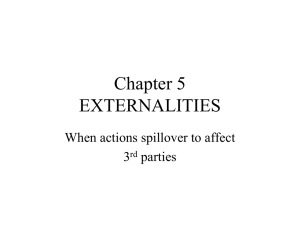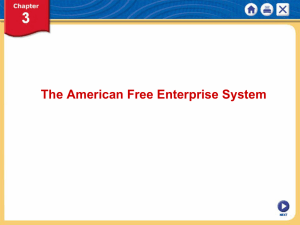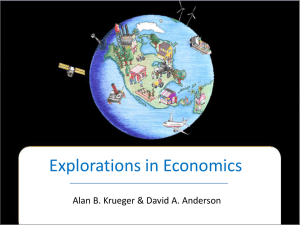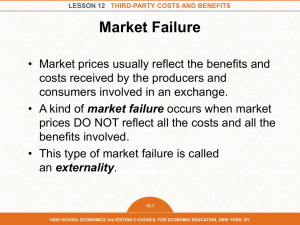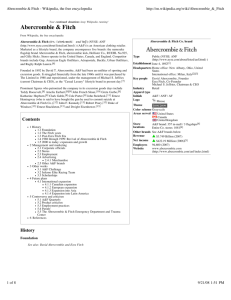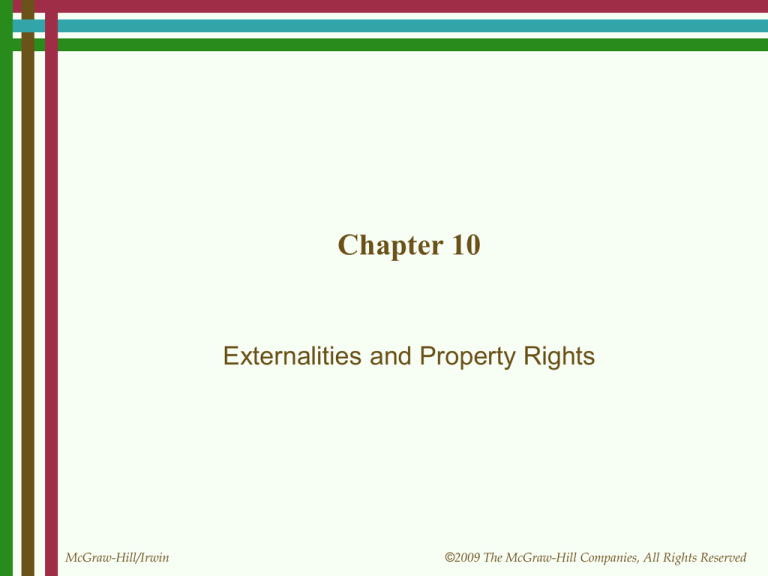
Chapter 10
Externalities and Property Rights
McGraw-Hill/Irwin
©2009 The McGraw-Hill Companies, All Rights Reserved
Learning Objectives
1. Define negative and positive externalities and analyze
their effect on resource allocations
2. Discuss and explain the Coase Theorem
3. Explain how the effects of externalities can be
remedied
4. Discuss why the optimal amount of an externality is
almost never zero
5. Characterize the tragedy of the commons and show
how private ownership is a way of preventing it
6. Define positional externalities and their effects
Show how they can be remedied
LO 10 - All
10 - 2
External Costs and Benefits
External cost is a cost of an activity that is paid by on
people other than those who pursue the activity
Also called a negative externality
External benefit is a benefit of an activity received by
a third party
Also called a positive externality
LO 10 - 1
10 - 3
Externalities Affect Resource Allocation
Externalities reduce economic efficiency
Solutions to externalities may be efficient
When efficient solutions to externalities are not
possible, government intervention or other collective
action may be used
LO 10 - 1
10 - 4
Honeybee Keeper – Scenario 1
Phoebe harvests and sells honey from her bees
Bees pollinate the apple orchards
No payments made to Phoebe
The bees provide a free service to the local farmers
Phoebe is giving away a service
Private costs are equal to private benefits
Social costs are less than social benefits
When external benefits exist,
maximizing private profits produces less
than the social optimum
LO 10 - 1
10 - 5
Honeybee Keeper – Scenario 2
Phoebe harvests and sells honey from her bees
Neighboring school and nursing homes are bothered by
bee stings
The bees are a nuisance to the neighbors
Phoebe is not paying all the costs of her honeybees
Private costs are equal to private benefits
Social costs are greater than social benefits
When external costs exist,
maximizing private profits produces more
than the social optimum
LO 10 - 1
10 - 6
External Costs
External Cost
Private
MC
1.3
D
12,000
Quantity (tons/year)
Price ($000s / ton)
Price ($000s / ton)
No External Cost
Social MC
$1,000/ton
2.3
2.0
Private
MC
1.3
D
8,000
12,000
Quantity (tons/year)
Deadweight loss from
pollution = $2 M/yr
LO 10 - 1
Social
Optimum
Private
Equilibrium
10 - 7
Positive Externality for Consumers
Deadweight loss from
positive externality
XB
Price
MBPVT + XB
MC
MBSOC
MBPVT
Social
Demand
Private Demand
Private
Equilibrium
LO 10 - 1
QPVT
Quantity
QSOC
Social
Optimum
10 - 8
Effects of Externalities
With externalities,
private market outcomes
do not achieve
the largest possible economic surplus
Cash is left on the table
LO 10 - 1
10 - 9
Remedying Externalities
With externalities, private market outcomes do not
achieve the largest possible economic surplus
Cash is left on the table
For example, with monopolies, output is lower than with
prefect competition
Introduction of coupons and rebates expands the
market
With externalities, actions to capture the surplus are
likely
LO 10 - 2
10 - 10
Abercrombie the Polluter – Scenario 1
Abercrombie’s company dumps toxic waste in the river
Fitch cannot fish the river
No one else is harmed
Abercrombie could install a filter to remove the harm to
Fitch
Filter imposes costs on Abercrombie
Filter benefits Fitch
Parties do not communicate
LO 10 - 2
10 - 11
Abercrombie's Filter Options
With Filter
Without Filter
Abercrombie's Gains
$100 / day
$130 / day
Fitch's Gains
$100 / day
$50 / day
Total Gains
$200 / day
$180 / day
Abercrombie does not install the filter
Marginal cost of filter to Abercrombie is $30 per day
The marginal benefit to Fitch is $50 per day
There is a net welfare loss of $20 per day
LO 10 - 2
10 - 12
Abercrombie the Polluter – Scenario 2
Communications changes the outcome
Fitch pays Abercrombie between $30 and $50 per
day to use the filter
Net gain in total surplus of $20 per day
With Filter
Without Filter
Abercrombie's Gains
$100 / day
$130 / day
Fitch's Gains
$100 / day
$50 / day
Total Gains
$200 / day
$180 / day
LO 10 - 2
10 - 13
The Coase Theorem
If people can negotiate the right to perform activities
that cause externalities, they can always arrive at
efficient solutions to problems caused by externalities
Negotiations must be costless
Sometimes those harmed pay to stop pollution
The case of Abercrombie and Fitch
Sometimes polluter buys the right to pollute
Abercrombie pays Fitch if the value of polluting is
greater than the harm to Fitch
The adjustment to the externality is usually done by the
party with the lowest cost
LO 10 - 2
10 - 14
Abercrombie the Polluter – Scenario 3
Abercrombie’s company produces toxic waste
Laws prohibit dumping the waste in the river
UNLESS Fitch agrees
New gains matrix
With Filter
Without Filter
Abercrombie's Gains
$100 / day
$150 / day
Fitch's Gains
$100 / day
$70 / day
Total Gains
$200 / day
$220 / day
LO 10 - 3
10 - 15
Abercrombie the Polluter – Scenario 3
Abercrombie can pay Fitch up to $50 per day for the
right to pollute
Fitch will accept any offer over $30 per day
In this scenario, polluting is the right thing to do
With Filter
Without Filter
Abercrombie's Gains
$100 / day
$150 / day
Fitch's Gains
$100 / day
$70 / day
Total Gains
$200 / day
$220 / day
LO 10 - 3
10 - 16
Laws Can Change the Outcome
Suppose the law makes polluters liable for the cost of
cleaning up their pollution
Polluters get lower incomes
Non-polluters get higher incomes
With Filter
Without Filter
Abercrombie's Gains
$100 / day
$150 / day
Fitch's Gains
$100 / day
$70 / day
Total Gains
$200 / day
$220 / day
LO 10 - 3
10 - 17
Shared Living
Ann and Betty are evaluating housing options
2-bedroom apartment for $600 per month OR
2 1-bedroom apartments for $400 per month each
If the costs were the same, Ann and Betty would be
indifferent between the two arrangements
The externality here is Ann's telephone usage is high
She would pay up to $250 per month to be able to
use the phone whenever she wants
Betty would pay up to $150 per month to get better
phone access
No second phone line is possible
LO 10 - 3
10 - 18
Benefits and Costs of Shared Living
Live together if the benefits exceed the costs
Total Cost of Separate
Apartments
Total Cost of
Shared Apartment
Rent Savings
from Sharing
$800 per month
$600 per month
$200 per month
Problem
Ann's Cost of
Solving the
Problem
Betty's Cost of
Solving the
Problem
Least-Cost
Solution
Ann's phone
usage
Pay Ann $250 to
decrease usage
Pay Betty $150
to tolerate Ann
Ann pays Betty
$150 per
month
LO 10 - 3
10 - 19
Net Benefit of Shared Living
Rent Savings
Cost of Phone
Accommodation
Gain in Surplus
$200 per month
$150 per month
$50 per month
Ann and Betty will live together
LO 10 - 3
10 - 20
Dividing the Rent
Betty would spend $400 per month to live alone
The cost of tolerating Ann's phone use is $150 per
month
Betty will be willing to pay up to $250 = $400 - $150
to live with Ann
Above $250, she will be better off living alone
Ann is willing to pay up to $400 per month, the cost of
living alone
LO 10 - 3
10 - 21
Dividing the Surplus
Betty's maximum rent is $250
Ann's maximum rent is $400
If they divide the surplus ($50) equally,
Betty pays $225 = $250 – $25
Ann pays $375 = $400 – 25
LO 10 - 3
10 - 22
Legal Remedies for Externalities
If negotiation is costless, the party with the lowest cost
usually makes the adjustment
Private solution is generally adequate
When negotiation is not costless laws may be used to
correct for externalities
The burden of the law can be placed on those who
have the lowest cost
LO 10 - 4
10 - 23
Examples of Legal Remedies for Externalities
Noise regulations (cars, parties, honking horns)
Most traffic and traffic-related laws
Car emission standards and inspections
Zoning laws
Building height and footprint regulations (sunshine
laws)
Air and water pollution laws
LO 10 - 4
10 - 24
Three Cases
Free Speech
First Amendment recognizes
the value of open
communications
Hard to identify speech that
has a net cost
Some limitations
Yelling "fire" in a crowded
theatre
Promote the violent
overthrow of the
government
Pornography
LO 10 - 4
Planting Trees
Government subsidizes trees
on private property
Decreases chances of
flooding and landslides
Net reduction of CO2 in the
atmosphere
Basic Research
Millions of dollars spent by
federal government yearly
Externalities of new
knowledge
10 - 25
Optimal Amount of Negative Externalities
MC & MB
MC
Optimal amount
of pollution
MC = MB
MB
Q
Quantity of Pollution
LO 10 - 4
10 - 26
Taxing a Negative Externality
Pollution Tax
$1,000 / ton
Social MC
2.3
2.0
XC
Private
MC
1.3
D
Quantity (tons/year)
LO 10 - 4
Private MC + Tax
Tax
2.0
Private MC
1.3
D
8,000 12,000
8,000 12,000
Social
Optimum
Price ($000s / ton)
Price ($000s / ton)
No Pollution Tax
Private
Equilibrium
Quantity (tons/year)
After Tax
Equilibrium
Before Tax
Equilibrium
10 - 27
Subsidizing a Positive Externality
Subsidy
14
MC
XB
10
8
Social
Demand
Price ($ / ton)
Price ($ / ton)
No Subsidy
Subsidy
14
10
8
Subsidized
Demand
Private
Demand
Private
Demand
12 16
Quantity
(000s tons/year)
LO 10 - 4
MC
12 16
Quantity
(000s tons/year)
10 - 28
Tragedy of Commons
When use of a communally owned resource has no
price, the costs of using it are not considered
Use of the property will increase until MB = 0
Suppose 5 villagers own land suitable for grazing
Each can spend $100 for either a steer or a
government bond that pays 13%
Villagers make sequential decisions
They know what everyone before them has done
Steers graze on the commons
Value of the steer in year 2 depends on herd size
LO 10 - 5
10 - 29
Payoff For a Steer
Using the information in the table below, each villager
makes a decision
# Steers
Selling Price per Steer
Income per Steer
1
126
26
2
119
19
3
116
16
4
113
13
5
111
11
The fourth is indifferent between the two assets
He buys a steer
The fifth buys a bond
LO 10 - 5
10 - 30
What the Villagers Did
The village has 4 steers feeding on the commons for
one year
At the end of the year, 4 steers sell for $113 each
Total revenue for the village is (5) (113) = $565
Outcome is the same as 5 bonds
They could have done better
LO 10 - 5
10 - 31
A Better Choice
# Steers
Selling
Price
Income per Total Cattle
steer
Income
Marginal
Income
1
126
26
26
26
2
119
19
38
12
3
116
16
48
10
Net income from one bond after one year is $13
Buy a steer only if its marginal benefit is at least $13
First villager buys a steer and all others buy bonds
Total net income is 26 + (4) (13) = $78
A net gain of $13 compared to the first scenario
Tragedy of the commons is the tendency for a resource that has
no price to be used until its marginal benefit is zero
LO 10 - 5
10 - 32
The Effect of Private Ownership
The villagers decide to auction off the rights to the
commons
Auction makes the highest bidder consider the
opportunity cost of grazing additional steers
Villagers can borrow and lend at 13%.
One steer is the optimal number
Winning bidder pays $100 for the right to use the
commons
LO 10 - 5
10 - 33
The Effect of Private Ownership
The winning bidder starts the year
Spends $100 in savings to buy a yearling steer
Borrows $100 at 13% to get control of commons
The winning bidder ends the year
Sells the steer for $126
Gets original $100 back
$13 opportunity cost of buying a steer
$13 interest on loan for the commons
Economic surplus of the village is
(4 x $13) + $26 = $78
LO 10 - 5
10 - 34
Property Rights and the Tragedy of Commons
Blackberries in the Park
Sweetness increases as the
berry ripens
Blackberries are common
property
Berries will be eaten before
they are fully ripe
Other Examples
Harvesting
Timber on remote public
land
Whales in open oceans
Worldwide pollution controls
LO 10 - 5
Shared Milkshakes
Milkshakes chill taste buds
Decrease appreciation of
its flavor
Drinking slowly increases
appreciation
If two people share the
milkshake, it is a common
good
They will drink faster than if
it were a private good
10 - 35
Positional Externalities
Highest compensation goes to the best performer
Standard is relative, not absolute
Each player increases spending to increase probability
of winning
Sum of all these investments > collective payoff
Total payout is fixed, so players' group has no gains
LO 10 - 6
10 - 36
Football Players Take Steroids
Smith and Jones compete for one $1 million contract
Each has 50% chance at the contract
Smith and Jones have a Prisoner's Dilemma
Jones's Options
Smith's
Options
No Steroids
Steroids
LO 10 - 6
No Steroids
2nd
best for each
Best for Smith
Worst for Jones
Steroids
Worst for Smith
Best for Jones
3rd best for each
10 - 37
Positional Externalities
Relative performance determines reward
Positional externalities occur when an increase in
one person's performance reduces the expected
reward of another
A positional arms race is a series of mutually
offsetting investments in performance enhancement
that is stimulated by a positional externalities
A positional arms control agreement attempts to
limit the mutually offsetting investments in
performance enhancements by contestants
LO 10 - 6
10 - 38
Examples of Positional Arms Control Agreements
Campaign spending limits
Roster limits
Arbitration agreements
Mandatory starting dates for kindergarten
Nerd norms
Fashion norms
Norms of taste
Norms against vanity
LO 10 - 6
10 - 39
Externalities and Property Rights
Effects of
External
Costs
Tragedy of
the Commons
Externalities and
Property Rights
Effects of
External
Benefits
Remedies
Coase Theorem
Positional
Externalities
Laws
Taxes & Subsidies
LO 10 - All
10 - 40





